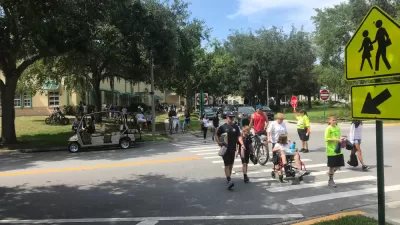Teenagers have a lot on their minds, which is not a bad thing, except when it comes to getting behind the wheel. A report released March 25 reveals that six out of ten teen crashes involve driver distraction—400 percent greater than a prior study.
As the AAA Foundation for Traffic Safety image below indicates, "distraction" is more than just talking or texting on a cell phone. "You might guess cell phones are the biggest distraction for young drivers, but guess again," reports CBS. "Simply chatting with other people in the car was the most common distraction leading to a crash for teen drivers."
According to the Centers for Disease Control and Prevention, motor vehicle crashes are the leading cause of death for American teens. "Researchers from the AAA Motor Club examined nearly 6,900 videos from families who had cameras mounted both on their teen drivers, and on the front windshield, as part of an education program," reports CBS," (t)he most comprehensive research ever conducted into crash videos of teen drivers," according to AAA.
“Access to crash videos has allowed us to better understand the moments leading up to a vehicle impact in a way that was previously impossible,” said Peter Kissinger, President and CEO of the AAA Foundation for Traffic Safety.
“This study shows how important it is for states to review their graduated driver licensing and distracted driving laws to ensure they provide as much protection as possible for teens,” continued AAA CEO Bob Darbelnet. “AAA recommends that state laws prohibit cell phone use by teen drivers and restrict passengers to one non-family member for the first six months of driving.”
The National Highway Traffic Safety Administration (NHTSA) "previously has estimated that distraction is a factor in only 14 percent of all teen driver crashes," notes AAA. According to NHTSA, in 2012, 3,328 Americans were killed in distracted driving crashes, less than 10 percent of the total of 33,561 highway deaths that year.
Founded in 1947, research by the AAA Foundation for Traffic Safety "is used to create focused, high-impact educational materials for drivers, pedestrians, bicyclists and road users of all ages."
FULL STORY: Other Passengers, Not Phones, The Biggest Distraction In Crashes For Teen Drivers

Maui's Vacation Rental Debate Turns Ugly
Verbal attacks, misinformation campaigns and fistfights plague a high-stakes debate to convert thousands of vacation rentals into long-term housing.

Planetizen Federal Action Tracker
A weekly monitor of how Trump’s orders and actions are impacting planners and planning in America.

Chicago’s Ghost Rails
Just beneath the surface of the modern city lie the remnants of its expansive early 20th-century streetcar system.

Bend, Oregon Zoning Reforms Prioritize Small-Scale Housing
The city altered its zoning code to allow multi-family housing and eliminated parking mandates citywide.

Amtrak Cutting Jobs, Funding to High-Speed Rail
The agency plans to cut 10 percent of its workforce and has confirmed it will not fund new high-speed rail projects.

LA Denies Basic Services to Unhoused Residents
The city has repeatedly failed to respond to requests for trash pickup at encampment sites, and eliminated a program that provided mobile showers and toilets.
Urban Design for Planners 1: Software Tools
This six-course series explores essential urban design concepts using open source software and equips planners with the tools they need to participate fully in the urban design process.
Planning for Universal Design
Learn the tools for implementing Universal Design in planning regulations.
planning NEXT
Appalachian Highlands Housing Partners
Mpact (founded as Rail~Volution)
City of Camden Redevelopment Agency
City of Astoria
City of Portland
City of Laramie




























